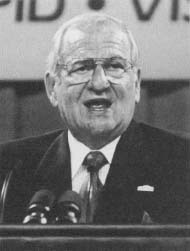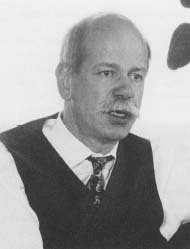Lee Iacocca
Born: October 15, 1924
Allentown, Pennsylvania
Business executive and former CEO,
Chrysler Corporation

Lee Iacocca obviously paid close attention to his parents and he certainly made something happen on more than one occasion. After a 32-year career with Ford Motor, including helping to design the Mustang sports car, Iacocca engineered one of history's greatest corporate comebacks at Chrysler. His success, coupled with appearances in television commercials and his best-selling books, made him one of the nation's most well-known and admired businessmen. While head of Chrysler, there was speculation that Iacocca might run for political office, even president of the United States, but he remained in the private sector even after retiring from Chrysler in 1993.
"People say to me, 'You were a roaring success. How did you do it?' I go back to what my parents taught me. Apply yourself. Get all the education you can, but then, by God, do something. Don't just stand there. Make something happen."
Learns Finances from His Father
Lido "Lee" Anthony Iacocca was born October 15, 1924, in Allentown, Pennsylvania, the son of Italian immigrants Nicola and Antoinette. He grew up in comfortable surroundings learning the nuts and bolts of business from his father. Nicola Iacocca was an entrepreneur who taught his son about the responsibilities of borrowing money and the need for a hard- driving vision in order to build a thriving business. Over the years the elder Iacocca worked as a cobbler, and owned a hot dog restaurant and a theater. He also ran one of the first car rental agencies in the country and passed on his love of the automobile to his son. When he was ten years old, Lee Iacocca worked as a freelance delivery person outside the local grocery store. He worked long hours in a fruit market at the age of sixteen.
When he graduated from high school, the United States was in the throes of World War II (1939-45). Iacocca was not required to join the military because he had rheumatic fever as a child, which left him in somewhat poor health. Instead he earned his bachelor's of science degree in industrial engineering from Lehigh University in Bethlehem, Pennsylvania. Upon graduation, he secured a coveted engineering trainee job at Ford, but delayed his start until he completed his master's degree at Princeton.
As one of a group of young engineers being groomed by Ford for a career in design and production, Iacocca quickly grew restless and became interested in the more dynamic worlds of sales and marketing. He was assigned to fleet sales in Ford's Chester, Pennsylvania, office, and over the next few years he honed his communications skills and ability to predict consumer trends. Confident and ambitious, Iacocca skyrocketed through the ranks of Ford's sales divisions.
Even as a teenager, Lee Iacocca decided that he was going to be an auto company executive and focused his studies in that direction. He first studied mechanical engineering and then, because of bad grades in physics, switched to industrial engineering, picking up several business and psychology courses along the way.
Hitting the Corporate Bull's-eye
It was the 1964 Mustang that secured Iacocca's position in automotive history. Recognizing that Ford needed a domestic winner, he set about looking for a market that had not been tapped by automakers. He landed on America's youth, a wealthy generation with car-buying potential. In his 1984 autobiography, Iacocca wrote: "Any car that would appeal to these young customers had to have three features: great styling, strong performance, and a low price. Developing a new model with all three would not be easy. But if it could be done, we had a shot at a major success." The shot hit the bull's-eye. Bolstered by an ambitious advertising campaign and favorable press coverage—the car was put on the cover of Newsweek and Time in the same week—419,000 Mustangs were sold over the next twelve months, a record for a first-year model.
Dieter Zetsche: German Engineer Takes Charge
In 2000, Dieter Zetsche took over as head of DaimlerChrysler's Chrysler Group, bringing his strong German presence and conservative financial philosophy to the newly formed company's American division. He instantly made waves when one of his fist cost-cutting acts was to lay off twenty-six thousand workers and close six plants.
Zetsche was born on May 5, 1953, in Istanbul, Turkey, where his father was working as an engineer for a construction firm. He grew up, however, in the German city of Frankfurt. One of his first jobs was driving a beverage truck. In 1976 Zetsche earned his master's degree in electrical engineering from Germany's University of Karlsruhe. He began at Daimler-Benz that same year, working in its research division. Five years later he became assitant to the chief engineer of the commercial vehicle division. In 1982, Zetsche received a doctorate in mechanical engineering from the Univeristy of Paderborn in Paderborn, Germany. The company named him chief engineer of Mercedes-Benz Brazil in 1987; two years later he was made president of Mercedes-Benz Argentina.

Zetsche's first experience in the American workplace came when Daimler-Benz transferred him to Portland, Oregon, in 1991 to serve as president of its troubled Freightliner Corporation, a commercial truck subsidiary. A year later, he returned to Germany and moved up in the company ranks. When a merger with U.S. automaker Chrysler was announced in 1998, Zetsche was moved to a DaimlerChrysler board position responsible for the commercial vehicle business. He took over as head of the Chrysler Group in 2000.
"Zetsche deserves respect," editor-in-chief Lindsay Brooke wrote in the December 2000 issue of Automotive Industries magazine. "He approaches challenges like the astute manager and engineer that he is. That's a valuable attribute, because Chrysler has lost so much that it must now recover with his leadership."
Iacocca served as president of Ford between 1970 and 1978, cutting costs, streamlining operations, and forcing managers to turn unprofitable divisions around during a rocky time in automotive history. The U.S. auto industry was facing intense competition from foreign companies and gasoline prices were rising dramatically, causing a temporary halt on new car purchases. Ironically, the managerial talent and marketing genius that had pushed Iacocca into the corporate limelight and given the company renewed success also brought him into conflict with Henry Ford II (1917-1987), the chairman and grandson of the company's founder. The differences gradually increased during the 1970s and culminated in 1978 when Ford fired Iacocca.
Five months after his firing, Iacocca was named president of Chrysler. He became chairman of its board of directors in 1979 and CEO in 1980. In a few years, he transformed the number-three automaker from a company near bankruptcy into a highly profitable enterprise. Iacocca turned Chrysler around by reducing expenses, winning approval of $1.5 billion in federal loan guarantees, selling off unprofitable units such as the military tank division, and introducing timely products. In 1984, the company posted profits of $2.4 billion, a total higher than it had made in the previous sixty years combined.
Because of the company turnaround and the quick payback of Chryler's loan guarantees, Iacocca became a star and a symbol of success. President Ronald Reagan (1911-) appointed him to oversee the restoration of the Statue of Liberty. He also became the television pitchman for Chrysler, a friendly face reassuring Americans that the country's great automotive history would remain strong. He was so popular that a 1985 opinion poll had him beating Vice President George Bush (1924-) in the 1988 presidential race, despite Iacocca's claim that he was not interested in the job.
Business Giant Stumbles
But the late 1980s and early 1990s were not as kind to the automotive giant. In the eyes of some, the famed business judgment that had catapulted Iacocca to stardom began to falter. Instead of reinvesting Chrysler's profits to produce new cars that would rival those of Japanese companies, Iacocca urged the company to expand. Among Chrysler's acquisitions were corporate jet-maker Gulfstream Aerospace, purchased for $637 million, and American Motors Corporation, bought for $757 million. The purchases seriously strained the company's financial resources.
Iacocca's popularity, like the company's earnings, began to fall off. His salary also became an issue. At one time he publicly announced that he was accepting a salary of only one dollar a year from Chrysler. That changed, however, and in 1987, Iacocca was taking home $18 million per year. In 1992, he called it quits and resigned from Chrysler. He remained as a consultant to the company, with a $500,000 a year salary and use of the company jet, until the end of 1994.
Lee Iacocca and Mary McCleary were married in 1956 and had two daughters, Kathi and Lia. Mary died of complications related to diabetes in 1983, and in her memory, all the profits from Iacocca's book sales go to help diabetes research.
In 1995, Iacocca announced that he was suing Chrysler, claiming that it unlawfully blocked him from exercising $42 million in share options that he had earned while he was the chairman. Before the lawsuit went to trial, Chrysler settled out of court, paying the former CEO $21 million. As he moved into the twenty-first century, Iacocca was still involved in the auto industry, investigating the market for electric cars in California. He even tried to rejoin Chrysler, but after several years of discussion, was turned down by DaimlerChrysler CEO Juergen Schrempp in 2002.
For More Information
Books
Dammann, George H. Seventy Years of Chrysler. Sarasota, FL: Crestline Publishing, 1974.
Iacocca, Lee. I Gotta Tell You: Speeches of Lee Iacocca. Detroit, MI: Wayne State University Press, 1994.
——. Iacocca: An Autobiography. New York: Bantam Books, 1984.
Levin, Doron P. Behind the Wheel at Chrysler. New York: Harcourt Brace & Company, 1995.
Yates, Brock W. The Critical Path. New York: Little, Brown & Company, 1996.
Periodicals
Brooke, Lindsay. "Dieter Takes Charge." Automotive Industries (December 2000): p. 7.
Burt, Tim. "Zetsche Outlines Plans to Increase Sales." The Financial Times (April 29, 2002): p. 26.
Connelly, Mary. "Slowing Minivan Sales Worry Struggling DCX." Automotive News (March 12, 2001): p. 3.
"Cutting Back at Chrysler." The Economist (February 3, 2001): p. 5.
"Iacocca Says No Room for Him at Chrysler." New York Times (March 18, 2002): p. C4.
Meredith, Robyn. "Batman and Robin." Forbes (March 5, 2001): p. 66.
"Putting a New Spin on DaimlerChrysler Corp." Ward's Auto World (March 1, 2001): p. 61.
Sheppard, Robert. "Chrysler's Crisis." Maclean's (February 12,2001): p. 38.
Taylor, Alexander L., III. "Iacocca's Tightrope Act." Time (March 21,1983): pp. 50-59.
Web Sites
Chrysler. [On-line] http://www.chrysler.com (accessed on August 15, 2002).
DaimlerChrysler AG. [On-line] www.daimlerchrysler.com (accessed on August 15, 2002).
Dodge. [On-line] http://www.dodge.com (accessed on August 15, 2002).
Jeep. [On-line] http://www.jeep.com (accessed on August 15, 2002).
Mercedes-Benz. [On-line] http://www.mercedesbenz.com (accessed on August 15, 2002).
Comment about this article, ask questions, or add new information about this topic: